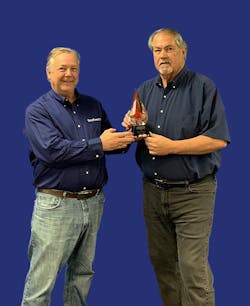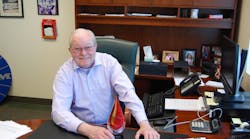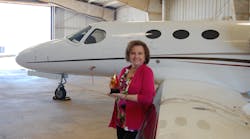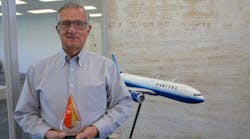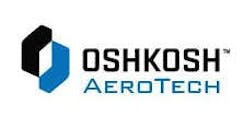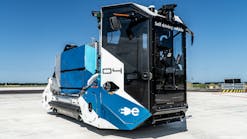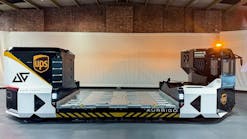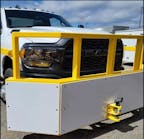Larry Laney: 2020 Lifetime Achievement
Since making the leap from the oil industry to aviation, Larry Laney has accomplished a great deal – a lifetime’s worth, really.
Beginning as a ground support equipment (GSE) mechanic more than 30 years ago, Laney worked his way to director of ground support at Southwest Airlines (SWA), leaving a lasting impression on the industry.
“Larry is above all else a man of honesty and integrity and this is his most admirable characteristic,” says Don Redwine, senior manager of fleet planning, reliability and warranty at Southwest Airlines. “Larry has helped me and all of us at SWA to recognize the importance of long-term strategic planning and patience. Having, and sticking to, a long-term plan until the goal is accomplished.”
Set to retire this spring, Laney has applied his professional skills and ability to formulate sound plans to guide his teams through a myriad of experiences.
“Larry is a great mentor and loyal leader,” Redwine says. “He has given all his direct reports opportunities to grow and flourish within the organization. His style is laid back but never out of touch.”
Having applied decades of experience to develop and expand the GSE fleet to support Southwest Airlines’ growth while positioning the next wave of leaders for success, Laney has been recognized with Ground Support Worldwide’s 2020 Lifetime Achievement award.
A Change in Career
Aviation has always been in the Laney family’s blood. Laney’s father had a private pilot’s license, and the town they lived in had a modest general aviation airport.
“We would go out and just sit there and watch the airplanes,” Laney says. “I kind of had the airplane bug as a youngster.”
But prior to Laney’s career in aviation, he established himself in the oil industry. He owned a small oil field construction company in Taft, Calif., but felt the effects of an oil crisis in 1986. When the business went under, Laney began looking for a new line of work and different place to live.
“I took it as an opportunity to make a change,” he explains.
“I was visiting some friends in Phoenix and looking for some work. That’s when, of course, oil was tanking, so airlines were making a lot of money because of cheap gas,” he recalls. “So, America West Airlines was growing leaps and bounds back in those days.”
Laney started as a GSE mechanic, working the midnight shift, for America West Airlines on April 1, 1986.
“Within a year or two, I went from mechanic to lead mechanic to supervisor,” he says.
Shortly after, America West’s manager of the Phoenix GSE hub, the airline’s largest hub, took a position in Tech Ops.
“It created an opening, and as one of the supervisors there, I was able to get the position of manager for GSE for America West Airlines,” Laney says. “Within a year or so, they rolled all the shops underneath me. Back then, Phoenix was the main hub, Vegas was big for us, so we had a shop there and we eventually opened a shop in Columbus, Ohio. So, that was the size of the department.
“The rest of the maintenance was contracted out at all the smaller stations, besides those three locations.”
It was during his 11 year-tenure at America West Airlines that Laney experienced his first major challenge in the aviation industry, working through a bankruptcy during the first Gulf War.
“As we were parking a percentages of airplanes, we had to lay off the same percentage of employees. It was a very difficult time,” Laney recalls. “I certainly got to learn a lot, going through my first crisis in the aviation business.
“We came out the other side a stronger company.”
Soon after, Laney was ready for a change. He says he had met some of the people at Southwest Airlines, including Bruce Premier, who was leading the GSE department for SWA.
“He gave me the opportunity to come over to Southwest Airlines and I jumped on that opportunity when I had the chance,” Laney says, adding the job included a move to Texas.
Hired on as a foreman on Aug. 1, 1997, Laney managed the Dallas shop and 11 other cities in the region. Before long, Laney was promoted to manager of GSE.
“I was the first manager of GSE, really, for Southwest Airlines,” Laney points out. “I essentially managed the whole system and reported to him. He was the director over ground support, cargo and central baggage.
“I was the manager running the GSE department and reporting to Bruce.”
When Premier was promoted to senior director, Southwest split up the divisions he oversaw. That’s when Laney was promoted to director of GSE.
“I’ve been director of GSE for a little over 20 years for Southwest Airlines,” Laney says. “I’m responsible for all the GSE nationwide, all the employees, the capital budget for the equipment, the sell of surplus when we’re done – every aspect of GSE, from it coming in the door until it leaves, is our responsibility.”
A Big Machine
Laney has experienced a lot in his time in aviation and has learned important lessons along the way. He says he has had a number of influential people help him throughout his career.
“I think my first mentor, in the GSE world and the aviation business in general, was Dick Barba,” Laney says. “He was who I reported to at America West Airlines. He was the one who hired me to take the manager’s position.
“We became really close friends, hunting buddies. We hung out together a lot.”
Laney says Barba gathered a lot of wisdom having come up through the industry in the early days of TWA. When he took Laney under his wing, he shared experiences from his own career.
“I got to learn all aspects of the airline and how they operate – and from the senior leadership side because he became a VP before I left,” Laney says. “He knocked the rough edges off me.”
Laney is also grateful to Premier for hiring him at Southwest, helping mentor him and teach him the ins and outs at Southwest.
“I give those two guys a lot of credit for helping me in my career,” Laney says.
Laney’s mark on the industry is highlighted by growth. As Southwest Airlines has grown, Laney has ensured the GSE has grown with it. That growth includes more sophisticated equipment, including a broader range of electric GSE.
“Larry's impact on SWA GSE has been very broad,” Redwine notes. “During his tenure, we have gone from a white board list of assets to an electronic fleet management system. We have built a world class refurb department for rebuilding older equipment. We have built one of the largest electric equipment fleets in the industry, taking advantage of numerous industry grants and partnerships.
“Under his leadership SWA has partnered with numerous manufactures to develop innovative solutions for our business, such as the hybrid towbarless tow tractor, a provisioning van, electric conventional pushback tractor, plastic baggage cart and gate PCAir hose trolley, among others.”
Laney recalls the very basic GSE in use 30 years ago.
“You had the Ford 6-cylinder C6 transmission and a Rockwell rear-end. It was just basic Ford axles and things in the belt-loaders, the same drivetrain,” Laney says. “It was very simplistic.”
Fast-forward today, Laney points out, and more than 25 percent of Southwest’s fleet is now electric.
“I’m really impressed with all the manufacturers and what they’re doing – from the early days to what’s available today; taking all the on-road technologies; all the smart transmissions; and all the different ways to control a vehicle to protect aircraft and our employees from injuries,” he says.
“Certainly, they’ve done very well as an industry working with their partners on what that technology means and the best way to use it for the end-users,” Laney says. “Over the long haul, I’m very impressed.”
Laney recalls an example of his team working with a manufacturer to build a product. Southwest was buying pushback tractors from FMC, before the company became JBT. However, FMC had not made an electric pushback yet.
“We had a shop in Phoenix, where our guys had actually taken and done many pushback tractors – some Stewart & Stevenson pushback tractors, older ones – and took the diesel engines out and converted them in-house,” Laney says. “We were one of the only airlines, that I know of, that was very aggressive doing that. So, we were converting the pushback tractors, diesel and gas belt-loaders to electric.”
He began discussions with FMC about building an electric version of their pushback. Laney worked with Norm Kosciusko to get the desired components to FMC’s manufacturing sites.
“He said, ‘Look, if you guys want to do this, why don’t you send us a rolling chassis with the axles in it, the steering system in it, minus the engine. You can send your engineers to our facility and they can work with our team to build a tractor,’” Laney says. “We worked real close together. They worked with our guys in the Phoenix shop, engineered their own and built that one. And they probably built us another hundred after that.
“So, it was a great partnership where I think it worked out well for both companies.”
The aircraft being serviced with GSE by ground handlers are large and complex, serving as a microcosm of the industry itself.
“It’s a big machine, an airline,” Laney says. “A lot of moving parts. A lot of people. So, I think the biggest thing that I’ve learned is it takes a great team to make that happen.”
Laney has always prioritized people and building strong, cohesive groups.
“Personally, I think one of the things I’m good at and give myself credit for is the teams that I’ve built while I was at America West and definitely here at Southwest Airlines,” Laney says. “I think the biggest thing I’ve learned is surround yourself with the best people you can find.
“Get out of their way and support them. Certainly, that has worked for me in my career at America West and Southwest,” he continues, noting nobody in his line of work runs an airline or a department by themselves. “It takes a lot of people to make things happen.”
Laney also notes the importance of listening to his team. That has allowed him to learn people’s personalities and put them in a position to succeed.
Understanding how someone will handle a role is part of putting a sound plan in place. And proper planning is crucial when experiencing the type of expansion that has taken place during Laney’s tenure.
“If you have a good core plan, you just keep growing that plan with the right people and it works out,” he says.
“In all the years of doing it, I’m still amazed at the complexity of putting everything together,” he adds. “I certainly have a newfound respect for those top leaders to be able to pull off what we do to make those flights go every day.
“People just don’t understand behind the scenes and what it takes.”
Like any line of work, challenges are encountered. Laney has navigated his people through several difficult events, from the terrorist attacks of Sept. 11, 2001, to economic recessions and the current COVID-19 pandemic.
“In any crisis, you got to be positive – even when you’re going through a challenging time,” says Laney, who has been named Team Leader of the Year twice by Ground Support Worldwide. “You’re going to get through it.”
When a crisis ends, Laney says teams come away stronger and receive a lesson on what can be accomplished during hard times.
Adversity also builds strong relationships and Laney is proud of the partnerships he has forged.
“I think the biggest accomplishment for me is, obviously, the relationships that I’ve built throughout the GSE industry and the mutual integrity with all of our vendors,” Laney says. “The relationships I’ve built are certainly major accomplishments to me. I think I’m well respected in the industry, and I think that’s a major accomplishment, as far as I’m concerned.
Retirement Plans
Laney is scheduled to retire on June 5. But given the current climate of the aviation industry, he is willing to stay on beyond that date.
“I still plan on leaving on the fifth. If they want me to stay longer, I will until we get on the other side of this crisis and things are looking better,” Laney says. “After everything the company’s done for me, I’ll hang out as long as I’m needed.”
Laney is tremendously grateful for the opportunities afforded him by Southwest Airlines and credits the company’s people-first approach.
“It’s just a great place to work,” Laney says. “I could rattle on like a two-dollar radio.
“I feel very, very fortunate to be lucky enough to come down here and be able to participate – especially at the director level – for over 20 years. It’s been special.”
He has applied those same characteristics to his team in order to develop the next generation of directors.
“We have programs where we’re tasked with developing the next leaders,” Laney says. “I’ve mentored the guys on my team. I certainly hope one of the senior managers on my team gets to take my place when I leave.”
When Laney’s last day at Southwest arrives, he looks forward to the having more time to golf, work on his 1969 El Camino and 1955 Ford F-100 and fly remote controlled airplanes.
“People keep asking me what I’m going to do. I keep saying, ‘Whatever I want,’” Laney says. “I may even stay engaged a little bit in the industry.”
He will also have more time to spend with his family, which he thanks for being willing to move from Phoenix to Dallas and being supportive of the time he spent on the road for work.
That support allowed Laney to achieve a great deal following his humble start as a mechanic.
“Essentially, I ended up working on GSE because that’s where my skillset was. That was my way to get into aviation,” Laney says. “Ground support equipment is a small industry, a tight-knit group. Once you get involved in that, you’re kind of hooked. It’s a small world with a lot of great friends.”
